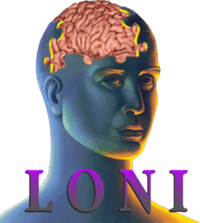Laboratory of Neuro Imaging
 | |
| Industry |
Education Research Science |
|---|---|
| Headquarters | Los Angeles, California, USA |
| Website | www.loni.usc.edu |
The Laboratory of Neuro Imaging (LONI) is a research laboratory founded within the Department of Neurology at the UCLA David Geffen School of Medicine. In September, 2013, LONI moved to Keck School of Medicine of USC. The laboratory conducts a wide variety of brain imaging studies of normal brain anatomy and function, development, aging, and disease. Historically, research at LONI has focused on design, development, validation and wide dissemination of software tools for use in understanding the relationships between brain structure and function across space, time and scale. In particular, work has been conducted toward the construction of multidimensional brain atlases seeking to promote computationally efficient representations of brain anatomy, function and physiology in a standardized 3D coordinate system. Brain imaging modalities include MRI, fMRI, Diffusion Tensor Imaging, Magnetic Resonance Spectroscopy, Positron Emission Tomography, Optical Intrinsic Signal, among other means for gathering spatially based neurophysiological signals.
Resources
The Laboratory of Neuro Imaging has deployed a comprehensive infrastructure for conducting advanced neuroimaging and brain mapping research. This infrastructure is based on the following types of resources:
- Software: LONI faculty and staff work to develop efficient computational algorithms and software for the quantitative mapping of brain structure and function.
- Scientific Data Workflows: the development of process oriented algorithms and meta-algorithms for assessing neuroimaging and other biologically relevant data sets. See LONI Pipeline for overview. See also discussions of Scientific Data Provenance.
- Databases: The LONI Image Database was developed to provide a flexible and effective interfaces for managing, archival and protection of neuroimaging data.
- Computational resources: Through a collection of complementary NIH grant mechanisms, LONI has sought to provide high-end computational servers, storage and networking facilities, which include Grid server, Gigabit network, Data Immersive Visualization Environment (DIVE) as well as brain tissue preparation, genetics, and microscopy laboratory space.
Research
Examples of the brain mapping research conducted at LONI include:
- Alzheimer's disease: Investigating structural, functional, metabolic and pathological changes triggered by Alzheimer's disease. LONI research focuses on characterizing the timecourse of pathology in the AD brain.
- Normal brain development and neurodevelopmental disorders: LONI development efforts have focused on assessing structural brain changes by mapping anatomical growth and pruning associated with both normal and abnormal brain development during childhood and adolescence.
- Optical Intrinsic Signal Imaging: Mapping the brain by measuring intrinsic activity-related changes in tissue reflectance.
- Schizophrenia: Mapping heritability and effects of risk genes on structural features in the brain.
- Atlasing of the C57BL/6J mouse brain
- Neuronal white matter tract tracing in the mouse
- Mathematical modeling
- Neuroscience databasing
- Applications of Grid computing in the neurosciences
See also
External links
Coordinates: 34°4′2″N 118°26′36″W / 34.06722°N 118.44333°W